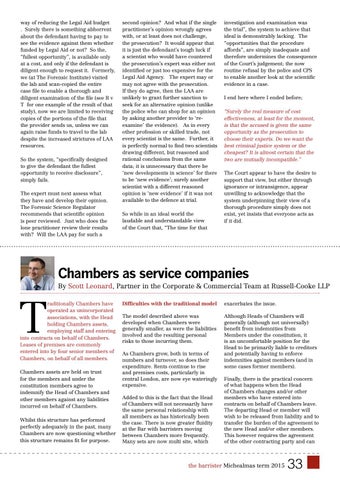way of reducing the Legal Aid budget . Surely there is something abhorrent about the defendant having to pay to see the evidence against them whether funded by Legal Aid or not? So the, “fullest opportunity”, is available only at a cost, and only if the defendant is diligent enough to request it. Formerly, we (at The Forensic Institute) visited the lab and scan-copied the entire case file to enable a thorough and diligent examination of the file (see R v T for one example of the result of that study), now we are limited to receiving copies of the portions of the file that the provider sends us, unless we can again raise funds to travel to the lab despite the increased strictures of LAA resources. So the system, “specifically designed to give the defendant the fullest opportunity to receive disclosure”, simply fails. The expert must next assess what they have and develop their opinion. The Forensic Science Regulator recommends that scientific opinion is peer reviewed. Just who does the lone practitioner review their results with? Will the LAA pay for such a
second opinion? And what if the single practitioner’s opinion wrongly agrees with, or at least does not challenge, the prosecution? It would appear that it is just the defendant’s tough luck if a scientist who would have countered the prosecution’s expert was either not identified or just too expensive for the Legal Aid Agency. The expert may or may not agree with the prosecution. If they do agree, then the LAA are unlikely to grant further sanction to seek for an alternative opinion (unlike the police who can shop for an opinion by asking another provider to ‘reexamine’ the evidence). As in every other profession or skilled trade, not every scientist is the same. Further, it is perfectly normal to find two scientists drawing different, but reasoned and rational conclusions from the same data; it is unnecessary that there be ‘new developments in science’ for there to be ‘new evidence’; surely another scientist with a different reasoned opinion is ‘new evidence’ if it was not available to the defence at trial. So while in an ideal world the laudable and understandable view of the Court that, “The time for that
investigation and examination was the trial”, the system to achieve that ideal is demonstrably lacking. The “opportunities that the procedure affords”, are simply inadequate and therefore undermines the consequence of the Court’s judgement; the now routine refusal by the police and CPS to enable another look at the scientific evidence in a case. I end here where I ended before;
“Surely the real measure of cost effectiveness, at least for the moment, is that the accused is given the same opportunity as the prosecution to choose their experts. Do we want the best criminal justice system or the cheapest? It is almost certain that the two are mutually incompatible.” The Court appear to have the desire to support that view, but either through ignorance or intransigence, appear unwilling to acknowledge that the system underpinning their view of a thorough procedure simply does not exist, yet insists that everyone acts as if it did.
Chambers as service companies By Scott Leonard, Partner in the Corporate & Commercial Team at Russell-Cooke LLP
T
raditionally Chambers have operated as unincorporated associations, with the Head holding Chambers assets, employing staff and entering into contracts on behalf of Chambers. Leases of premises are commonly entered into by four senior members of Chambers, on behalf of all members. Chambers assets are held on trust for the members and under the constitution members agree to indemnify the Head of Chambers and other members against any liabilities incurred on behalf of Chambers. Whilst this structure has performed perfectly adequately in the past, many Chambers are now questioning whether this structure remains fit for purpose.
Difficulties with the traditional model
exacerbates the issue.
The model described above was developed when Chambers were generally smaller, as were the liabilities involved and the resulting personal risks to those incurring them.
Although Heads of Chambers will generally (although not universally) benefit from indemnities from Members under the constitution, it is an uncomfortable position for the Head to be primarily liable to creditors and potentially having to enforce indemnities against members (and in some cases former members).
As Chambers grow, both in terms of numbers and turnover, so does their expenditure. Rents continue to rise and premises costs, particularly in central London, are now eye wateringly expensive. Added to this is the fact that the Head of Chambers will not necessarily have the same personal relationship with all members as has historically been the case. There is now greater fluidity at the Bar with barristers moving between Chambers more frequently. Many sets are now multi site, which
Finally, there is the practical concern of what happens when the Head of Chambers changes and/or other members who have entered into contracts on behalf of Chambers leave. The departing Head or member will wish to be released from liability and to transfer the burden of the agreement to the new Head and/or other members. This however requires the agreement of the other contracting party and can
the barrister Michealmas term 2015
33
